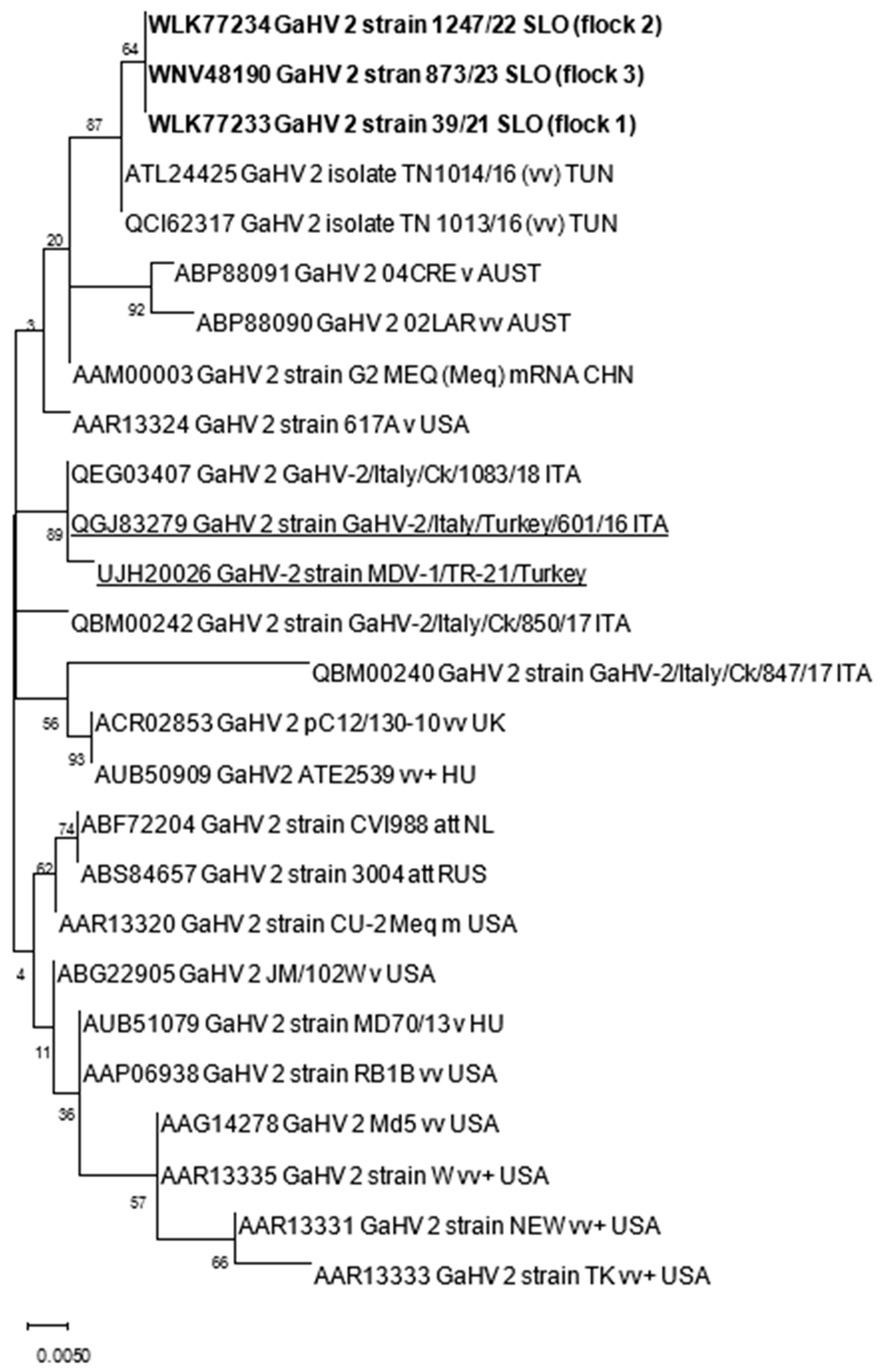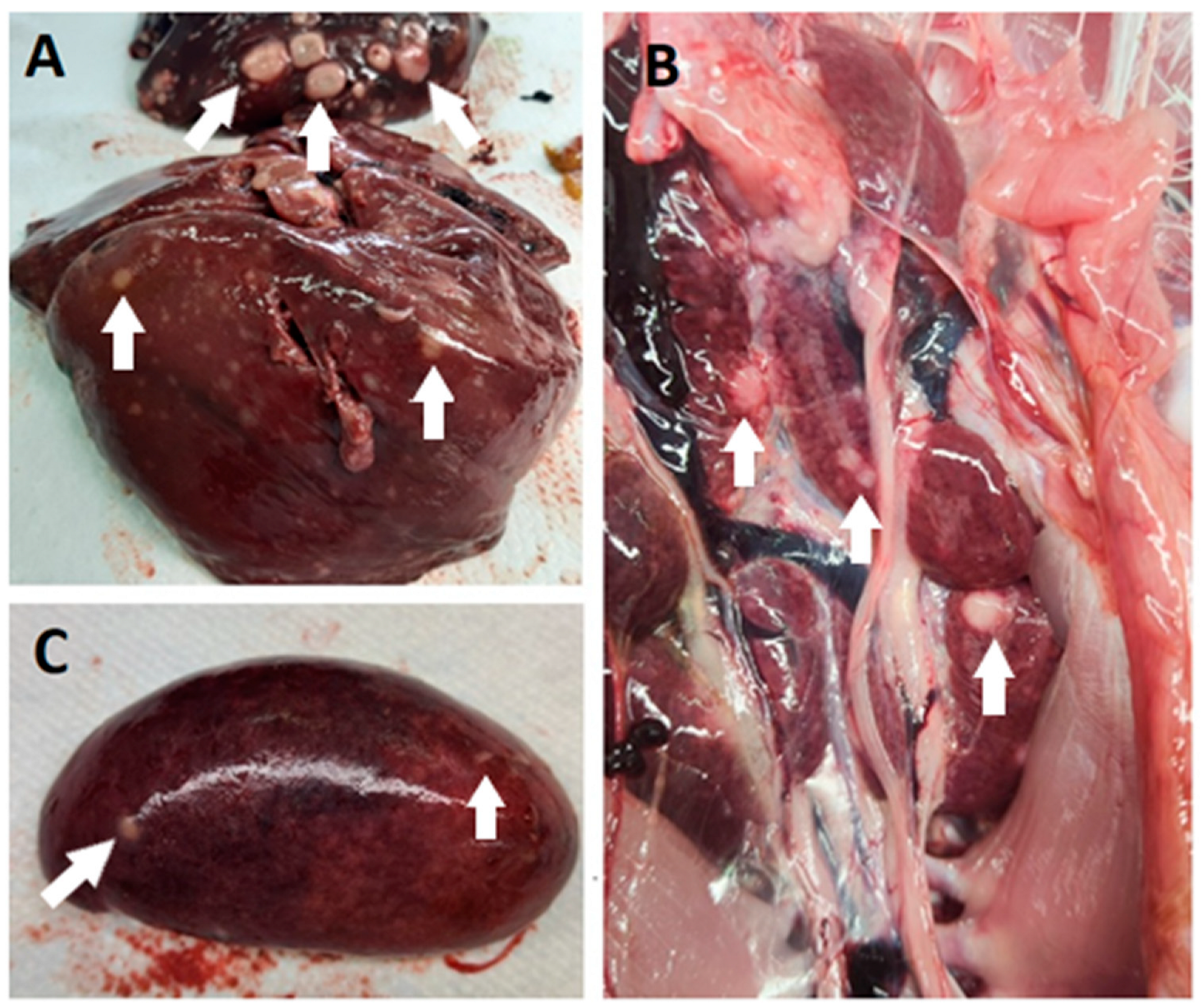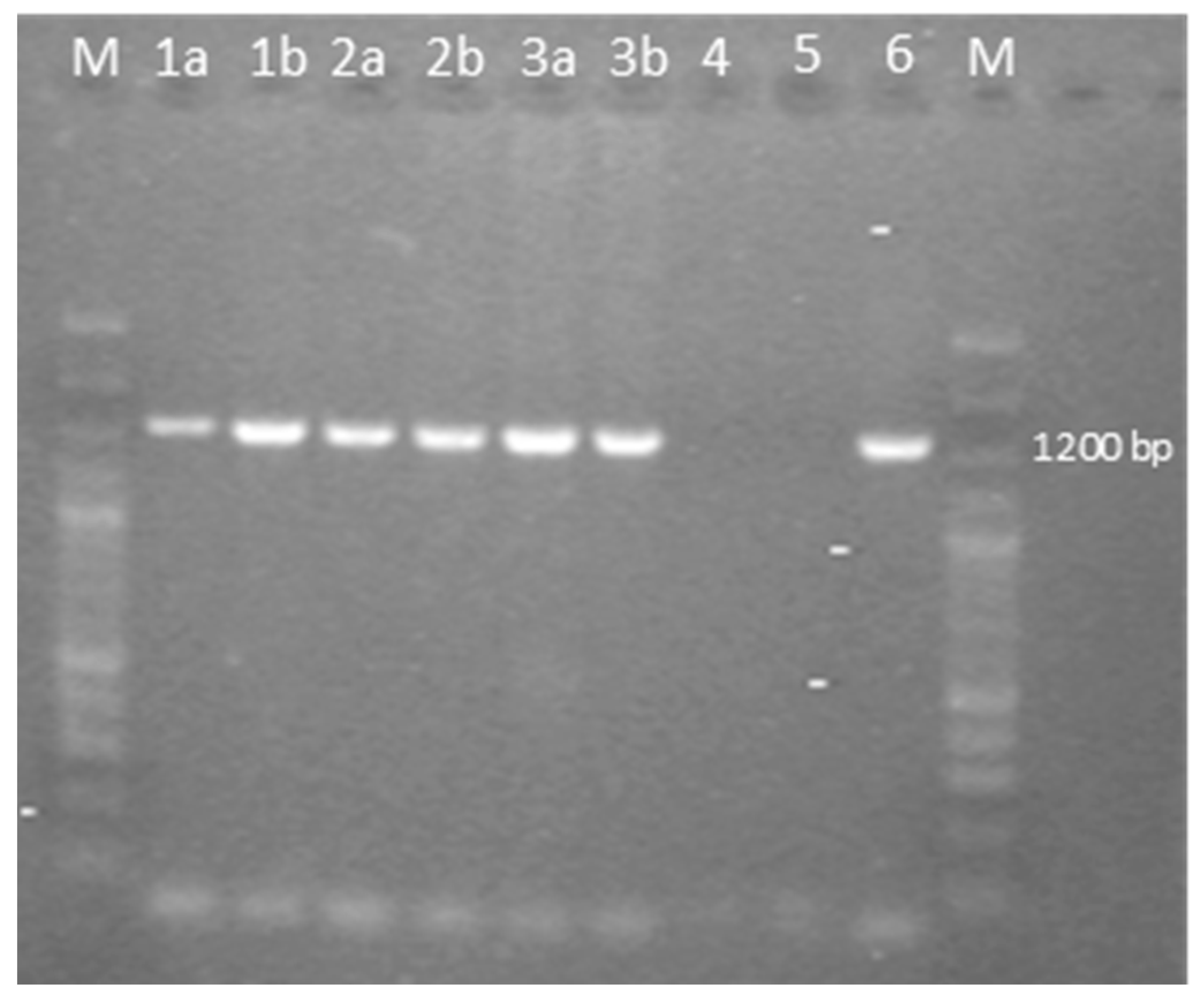First Report of Marek’s Disease Virus in Commercial Turkeys in Slovenia
Abstract
Simple Summary
Abstract
1. Introduction
2. Materials and Methods
2.1. Case History
2.2. Pathology/Histopathology
2.3. DNA Extraction from Tissue Samples
2.4. Detection of Viruses by PCR
2.4.1. Detection of MDV by PCR Assay
2.4.2. Detection of REV by Real-Time PCR (qPCR) Assay
2.4.3. Detection of LPDV by PCR Assay
2.5. Phylogenetic Analysis
3. Results
3.1. Gross and Histopathological Findings
3.2. Detection of Viruses by PCR
4. Discussion
5. Conclusions
Author Contributions
Funding
Institutional Review Board Statement
Informed Consent Statement
Data Availability Statement
Acknowledgments
Conflicts of Interest
References
- Nair, V.; Gimeno, I.; Dunn, J.; Zavala, G.; Williams, S.M.; Reece, R.L.; Hafner, S. Neoplastic diseases. In Diseases of Poultry, 14th ed.; Swayne, D.E., Boulianne, M., Logue, C.M., McDougald, L.R., Nair, V., Suarez, D.L., Wit, S., Grimes, T., Johnson, D., Kromm, M., et al., Eds.; John Wiley & Sons, Inc.: Hoboken, NJ, USA, 2020; Volume 1, pp. 548–637. [Google Scholar] [CrossRef]
- Davison, A.J.; Eberle, R.; Ehlers, B.; Hayward, G.S.; McGeoch, D.J.; Minson, A.C.; Pellet, P.E.; Roizman, B.; Studdert, M.J.; Thiry, E. The order Herpesvirales. Arch. Virol. 2019, 154, 171–177. [Google Scholar] [CrossRef] [PubMed]
- Blake-Dyke, C.; Baigent, S. Marek’s disease in commercial turkey flocks. Vet. Rec. 2013, 173, 376. [Google Scholar] [CrossRef] [PubMed]
- Abdul-Aziz, T.; Barnes, H.J. Gross Pathology of Avian Diseases: Text and Atlas; The American Association of Avian Pathologists: Jacksonville, FL, USA, 2018; pp. 122–134. [Google Scholar]
- Witter, R.L.; Calnek, B.W.; Buscaglia, C.; Gimeno, I.M.; Schat, K.A. Classification of Marek’s disease viruses according to pathotype: Philosophy and methodology. Avian Pathol. 2005, 34, 75–90. [Google Scholar] [CrossRef]
- Wozniakowski, G.; Mamczur, A.; Samorek-Salamonowicz, E. Common occurrence of Gallid herpesvirus-2 with reticuloendotheliosis virus in chickens caused by possible contamination of vaccine stocks. J. Appl. Microbiol. 2015, 118, 803–808. [Google Scholar] [CrossRef]
- Voute, A.J.; Wagenaar-Schaafsma, A.F. Een op de ziekte van Marek lijkende afwijking bij mestkalkoenen in Nederland. Tijdschr. Diergeneesk 1974, 99, 166–169. [Google Scholar]
- Coudert, F.; Vuillaume, A.; Wyers, M.; Legros, F.X. Une Nouvelle Pathologie chez la Dinde. La Maladie de Marek. In 1ères Journées de la Recherche Avicole Angers; INRA Institut National de la Recherche Agronomique: Paris, France, 1995; pp. 164–166. [Google Scholar]
- Voelckel, K.; Bertram, E.; Gimeno, I.; Neumann, U.; Kaleta, E.F. Evidence for Marek’s disease in turkeys in Germany: Detection of MDV-1 using the polymerase chain reaction. Acta Virol. 1999, 43, 143–147. [Google Scholar]
- Davidson, I.; Malkinson, M.; Weisman, Y. Marek’s disease in turkeys. I. A seven-year survey of commercial flocks and experimental infection using two field isolates. Avian Dis. 2002, 46, 314–321. [Google Scholar] [CrossRef]
- Pennycott, T.W.; Venugopal, K. Outbreak of Marek’s disease in a flock of turkeys in Scotland. Vet. Rec. 2002, 150, 277–279. [Google Scholar] [CrossRef]
- Mescolini, G.; Lupini, C.; Davidson, I.; Massi, P.; Tosi, G.; Catelli, E. Marek’s disease viruses circulating in commercial poultry in Italy in the years 2015–2018 are closely related by their meq gene phylogeny. Transbound. Emerg. Dis. 2020, 67, 98–107. [Google Scholar] [CrossRef]
- Hauck, R.; Mays, J.; Dunn, J.R.; Shivaprasad, H.L. Two cases of Marek’s disease in backyard turkeys. Avian Dis. 2020, 64, 347–351. [Google Scholar] [CrossRef]
- Ongor, H.; Timurkaan, N.; Abayli, H.; Karabulut, B.; Kalender, H.; Tonbak, S.; Eroksuz, H.; Çetinkaya, B. First report of Serotype-1 Marek’s disease virus (MDV-1) with oncogenic form in backyard turkeys in Turkey: A molecular analysis study. BMC Vet. Res. 2022, 18, 30. [Google Scholar] [CrossRef] [PubMed]
- Shehata, A.A.; Lüschow, D.; Hafez, M. History and current status of Marek’s disease in turkeys. Ger. J. Vet. Res. 2021, 1, 1–6. [Google Scholar] [CrossRef]
- Mescolini, G.; Lupini, C.; Felice, V.; Guerrini, A.; Silveira, F.; Cecchinato, M.; Catelli, E. Molecular characterization of the meq gene of Marek’s disease viruses detected in unvaccinated backyard chickens reveals the circulation of low and high-virulence strains. Poult. Sci. 2019, 98, 3130–3137. [Google Scholar] [CrossRef]
- Sun, F.; Ferro, P.J.; Lupiani, B.; Kahl, J.; Morrow, M.E.; Flanagan, J.P.; Estevez, C.; Clavijo, A. A duplex real-time polymerase chain reaction assay for the simultaneous detection of long terminal repeat regions and envelope protein gene sequences of Reticuloendotheliosis virus in avian blood samples. J. Vet. Diagn. Investig. 2011, 23, 937–941. [Google Scholar] [CrossRef] [PubMed]
- Allison, A.B.; Keel, M.K.; Philips, J.E.; Cartoceti, A.N.; Munk, B.A.; Nemeth, N.M.; Welsh, T.I.; Thomas, J.M.; Crum, J.M.; Lichtenwalner, A.B.; et al. Avian oncogenesis induced by lymphoproliferative disease virus: A neglected or emerging retroviral pathogen. Virology 2014, 2, 2–12. [Google Scholar] [CrossRef] [PubMed]
- Altschul, S.F.; Gish, W.; Miller, W.; Myers, E.W.; Lipman, D.J. Basic local alignment search tool. J. Mol. Biol. 1990, 215, 403–410. [Google Scholar] [CrossRef]
- Kumar, S.; Stecher, G.; Li, M.; Knyaz, C.; Tamura, K. MEGA X: Molecular Evolutionary Genetics Analysis across computing platforms. Mol. Biol. Evol. 2018, 35, 1547–1549. [Google Scholar] [CrossRef]
- Spatz, S.J.; Petherbridge, L.; Zhao, Y.G.; Nair, V. Comparative full-length sequence analysis of oncogenic and vaccine (Rispens) strains of Marek’s disease virus. J. Gen. Virol. 2007, 88, 1080–1096. [Google Scholar] [CrossRef]
- Shamblin, C.E.; Greene, N.; Arumugaswami, V.; Dienglewicz, R.L.; Parcells, M.S. Comparative analysis of Marek’s disease virus (MDV) glycoprotein-, lytic antigen pp38- and transformation antigen Meq-encoding genes: Association of meq mutations with MDVs of high virulence. Vet. Microbiol. 2004, 102, 147–167. [Google Scholar] [CrossRef]
- Trimpert, J.; Groenke, N.; Jenckel, M.; He, S.L.; Kunec, D.; Szpara, M.L.; Spatz, S.J.; Osterrieder, N.; McMahon, D.P. A phylogenomic analysis of Marek’s disease virus reveals independent paths to virulence in Eurasia and North America. Evol. Appl. 2017, 10, 1091–1101. [Google Scholar] [CrossRef]
- Renz, K.G.; Cooke, J.; Clarke, N.; Cheetham, B.F.; Hussain, Z.; Islam, A.; Tannock, G.A.; Walkden-Brown, S.W. Pathotyping of Australian isolates of Marek’s disease virus and association of pathogenicity with meq gene polymorphism. Avian Pathol. 2012, 41, 161–176. [Google Scholar] [CrossRef] [PubMed]
- Spatz, S.J.; Silva, R.F. Polymorphisms in the repeat long regions of oncogenic and attenuated pathotypes of Marek’s disease virus 1. Virus Genes 2007, 35, 41–53. [Google Scholar] [CrossRef] [PubMed]
- Tulman, E.R.; Afonso, C.L.; Lu, Z.; Zsak, L.; Rock, D.L.; Kutish, G.F. The genome of a very virulent Marek’s disease virus. J. Virol. 2000, 74, 7980–7988. [Google Scholar] [CrossRef] [PubMed]
- Spatz, S.J.; Smith, L.P.; Baigent, S.J.; Petherbridge, L.; Nair, V. Genotypic characterization of two bacterial artificial chromosome clones derived from a single DNA source of the very virulent gallid herpesvirus-2 strain C12/130. J. Gen. Virol. 2011, 92, 1500–1507. [Google Scholar] [CrossRef] [PubMed]
- Lachheb, J.; Mastour, H.; Nsiri, J.; Kaboudi, K.; Choura, I.; Ammouna, F.; Amara, A.; Ghram, A. Newly detected mutations in the Meq oncogene and molecular pathotyping of very virulent Marek’s disease herpesvirus in Tunisia. Arch. Virol. 2020, 165, 2589–2597. [Google Scholar] [CrossRef] [PubMed]
- Wei, P.; Cui, Z. The comparison of meq gene sequences amplified from different pathotypes of Marek’s disease virus. Chin. J. Prev. Vet. Med. 2002, 24, 88–92. [Google Scholar]
- Payne, L.N.; Venugopal, K. Neoplastic diseases: Marek’s disease, avian leukosis and reticuloendotheliosis. Rev. Sci. Tech. 2000, 19, 544–564. [Google Scholar] [CrossRef]
- Payne, L.N.; Frazier, J.A.; Powell, P.C. Pathogenesis of Marek’s disease. Int. Rev. Exp. Pathol. 1976, 16, 59–154. [Google Scholar]
- Elmubarak, A.K.; Sharma, J.M.; Witter, R.L.; Nazerian, K.; Sanger, V.L. Induction of lymphomas and tumor antigen by Marek’s disease virus in turkeys. Avian Dis. 1981, 25, 911–926. [Google Scholar] [CrossRef]
- Nazerian, K.; Elmubarak, A.; Sharma, J.M. Establishment of B-lymphoblastoid cell lines from Marek’s disease virus–induced tumors in turkeys. Int. J. Cancer 1982, 29, 63–68. [Google Scholar] [CrossRef]
- Crespo, R.; Woolcock, P.R.; Fadly, A.M.; Hall, C.; Shivaprasad, H.L. Characterization of T-cell lymphomas associated with an outbreak of reticuloendotheliosis in turkeys. Avian Pathol. 2002, 31, 355–361. [Google Scholar] [CrossRef] [PubMed][Green Version]
- Witter, R.L. Increased virulence of Marek’s disease virus field isolates. Avian Dis. 1997, 41, 149–163. [Google Scholar] [CrossRef] [PubMed]
- Zlabravec, Z.; Krapez, U.; Slavec, B.; Vrezec, A.; Rojs, O.Z.; Racnik, J. Detection and phylogenetic analysis of herpesviruses detected in wild owls in Slovenia. Avian Dis. 2018, 62, 397–403. [Google Scholar] [CrossRef] [PubMed]



| Pathogen | Target Gene | Primer Name | Primer Sequence 5′–3′ | Amplicon Size (bp) | Reference |
|---|---|---|---|---|---|
| REV | rev envelope gene | env-F | tcactctcgatggaaattgcag | [17] | |
| env-R | ccagtcctattgtctgcttccc | 96 | |||
| env probe | FAM-tagatgtcaactgctatgca-MGBNFQ | ||||
| ltr gene | LTR-F | aggctcataaaccataaaaggaaatgt | |||
| LTR-R | cctttacaaccattggctcagtatg | 119 | |||
| LTR probe | FAM-acaaacacgagatcgaacta-MGBNFQ | ||||
| LPDV | p31-ca gene | LPDV F | atgaggacttgttagattggttac | 457 | [18] |
| LPDV R | tgatggcgtcagggctatttg | ||||
| MDV | meq oncogene | EcoR-F | ggtgatataaagacgatagtcatg | 1622 | [16] |
| EcoR-R | ctccaggagttccgaagtatgag | ||||
| meq-pur-F1 meq-pur-R1 | ccgcacactgattcctaggca ggattgtgcggggtggtaagc | 506 | This study | ||
| meq-pur-F2 meq-pur-R2 | ggagaagacgcagggagcag gaaggccccggagcgtag | 406 | |||
| meq-pur-F3 meq-pur-R3 | cgctccacattgctccgg gggatcctcggtaagacgagc | 622 | |||
| meq-pur-F4 meq-pur-R4 | ctacgctccggggctctg ggggcatagacgatgtgctgc | 517 |
| GaHV-2 strain | Country | Year | Pathotype | Size of Meq (aa) | PPPPs | Host | Accession Number | References |
|---|---|---|---|---|---|---|---|---|
| CVI988 | Netherlands | 1969 | att | 398 | 7 | NA | DQ530348 | [21] |
| 3004 | Russia | NA | att | 398 | 7 | NA | EU032468 | NA |
| CU-2 | US | 1970s | m | 398 | 7 | Gallus gallus | AY362708 | [22] |
| MD70/13 | Hungary | 1970 | v | 339 | 5 | Gallus gallus | MF431495 | [23] |
| 617A | US | 1993 | v | 339 | 4 | NA | AY362712 | [22] |
| 04CRE | Australia | 2004 | v | 398 | 5 | NA | EF523773 | [24] |
| JM/102w | US | NA | v | 399 | 7 | DQ534539 | [25] | |
| Md5 | US | 1977 | vv | 339 | 4 | NA | AF243438 | [26] |
| C12/130 | UK | 1992 | vv | 339 | 5 | chicken | FJ436096 | [27] |
| 02LAR | Australia | 2002 | vv | 398 | 5 | chicken | EF523772 | [24] |
| RB1B | US | NA | vv | 339 | 5 | NA | AY243332 | [22] |
| New | US | 1999 | vv+ | 339 | 2 | NA | AY362719 | [22] |
| W | US | 1999 | vv+ | 339 | 4 | NA | AY362723 | [22] |
| ATE2539 | Hungary | 2000 | vv+ | 339 | 5 | Gallus gallus | MF431493 | [23] |
| TK | US | NA | vv+ | 339 | 2 | chicken | AY362721 | [22] |
| Italy/Ck/1083/18 | Italy | 2018 | NA (vv/vv+) | 339 | 4 | commercial chicken | MK855066 | [12] |
| Italy/Turkey/601/16 | Italy | 2016 | NA (vv/vv+) | 339 | 4 | meat-type turkey | MN017102 | [12] |
| Italy/Ck/850/17 | Italy | 2017 | NA (vv/vv+) | 339 | 5 | backyard chicken | MK139674 | [16] |
| TN1013/16 | Tunisia | 2016 | NA (vv/vv+) | 339 | 4 | Gallus gallus | MK041219 | [28] |
| TN1014/16 | Tunisia | 2016 | NA (vv/vv+) | 339 | 4 | Gallus gallus | KY113150 | [28] |
| Italy/Ck/847/17 | Italy | 2017 | NA (vv/vv+) | 418 | 10 | backyard chicken | MK139672 | [16] |
| MDV-1/TR21/turkey | Turkey | 2021 | NA (vv/vv+) | 339 | 4 | backyard turkey | OK322357 | [14] |
| G2 | China | 2002 | NA | 339 | 4 | chicken | AF493556 | [29] |
Disclaimer/Publisher’s Note: The statements, opinions and data contained in all publications are solely those of the individual author(s) and contributor(s) and not of MDPI and/or the editor(s). MDPI and/or the editor(s) disclaim responsibility for any injury to people or property resulting from any ideas, methods, instructions or products referred to in the content. |
© 2024 by the authors. Licensee MDPI, Basel, Switzerland. This article is an open access article distributed under the terms and conditions of the Creative Commons Attribution (CC BY) license (https://creativecommons.org/licenses/by/4.0/).
Share and Cite
Žlabravec, Z.; Slavec, B.; Rožmanec, E.; Koprivec, S.; Dovč, A.; Zorman Rojs, O. First Report of Marek’s Disease Virus in Commercial Turkeys in Slovenia. Animals 2024, 14, 250. https://doi.org/10.3390/ani14020250
Žlabravec Z, Slavec B, Rožmanec E, Koprivec S, Dovč A, Zorman Rojs O. First Report of Marek’s Disease Virus in Commercial Turkeys in Slovenia. Animals. 2024; 14(2):250. https://doi.org/10.3390/ani14020250
Chicago/Turabian StyleŽlabravec, Zoran, Brigita Slavec, Ema Rožmanec, Saša Koprivec, Alenka Dovč, and Olga Zorman Rojs. 2024. "First Report of Marek’s Disease Virus in Commercial Turkeys in Slovenia" Animals 14, no. 2: 250. https://doi.org/10.3390/ani14020250
APA StyleŽlabravec, Z., Slavec, B., Rožmanec, E., Koprivec, S., Dovč, A., & Zorman Rojs, O. (2024). First Report of Marek’s Disease Virus in Commercial Turkeys in Slovenia. Animals, 14(2), 250. https://doi.org/10.3390/ani14020250






